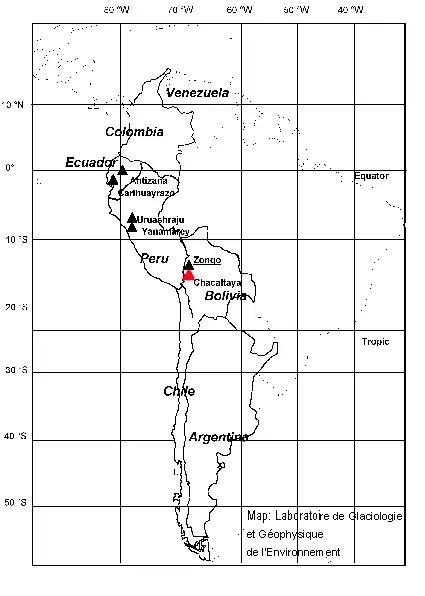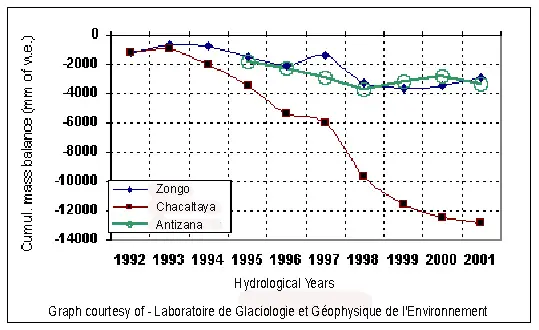The Chacaltaya Glacier in Bolivia is home to Bolivia’s only ski resort. The glacier on Chacaltaya is located at 16°21′12″S, 68°07′53″W. It is notable for being the world’s highest lift-served ski area, as well as the northernmost ski area in South America and the world’s most equatorial. The rope tow, the very first in South America, was built in 1939 using an automobile engine. The slopes run between 5,200 to 5,400 metres (17,000 and 17,700 ft) and are for skiers who are already acclimatised to the altitude.
Over the last decade, mass balance has been monitored on several glaciers of the tropical Andes by the Institute of Research for Development (IRD, France) in collaboration with South American partners. Included in this monitoring is the Chacaltaya glacier, seen on the map below.

The IRD report states that, “During the last decade, mass balance in this region has experienced a strongly negative trend. Large glaciers, such as Zongo and Antizana, lost 3-5 metres of water-equivalent, whereas small ones, such as the Chacaltaya Glacier in Bolivia, have retreated even more dramatically, with a deficit as high as 13 metres of water-equivalent (see chart below). The glaciers in the tropical Andes have been retreating in a coherent way, which suggests a common response to a global climate forcing along the mountain chain.”

The recent quickening of glacial melt in the Andes matches the greater intensity and frequency of El Niño events for the same period of time. Andean glaciers are particularly sensitive to climatic fluctuations owing to the position of most of them in the tropics, the ambient air temperature and the specific mechanisms by which they function. This in contrast with the glaciers in the Alps which have a long period of accumulation in winter. The glaciers in the tropics are subject to a higher rate of melting in the lower half of the glacier. This makes the snow and ice mass of tropical glaciers sensitive to the slightest sudden variation in climate.
The glacier shrinkage observed during the 1991-2001 period indicates a clear acceleration glacial melt. The Chacaltaya Glacier in Bolivia is not alone, and research indicates that glaciers are increasingly receding throughout the Andes. Jaime Argollo Bautista, director of the Institute of Geological Investigation at the University of San Andrés, in La Paz said that “Chacaltaya’s melting has been especially quick, with more than 80 percent of the glacier being lost in 20 years.” In February of 2007, Jaime said he would give the glacier three more years and it would all be gone.
Around the world glaciers are retreating , and a number of other them, such as the, Himalayan Gangotri glacier, Athabasca, glacier in the Canadian Rockies, andDavos in the Swiss Alps are melting quickly.
